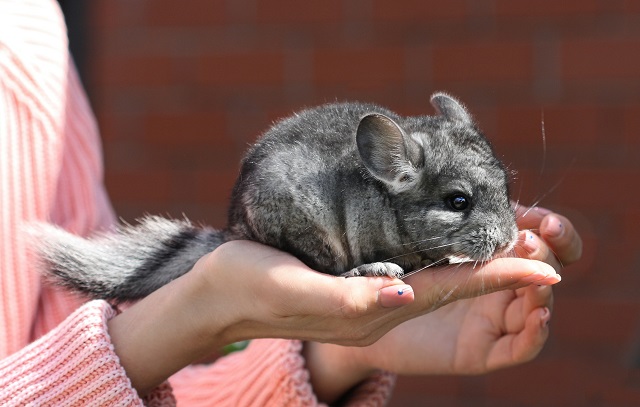
Chinchillas typically live about 15 years, with living up to 22 years not being uncommon. Their body length is about 10-14 inches, and the tail adds another 5-6 inches. With gentle handling from a young age most chinchillas will become quite tame and bond closely with their owners, although sometimes they do not like to be held or cuddled.
They are very active and playful. They can be kept singly, and usually will do fine as same sex pairs especially if they are litter mates or introduced at a young age. Chinchillas are largely nocturnal so will be most active at night. Sometimes they are called crepuscular, meaning their activity peaks at dawn and dusk. In any case, they should be kept in a fairly quiet area during the day. They prefer a consistent routine for handling at feeding times and may be stressed by changes to their routine. Since they are so active and playful, chinchillas need a roomy cage for exercise as well as daily playtime. Warm temperatures are more of a concern for chinchillas than cool temperatures, so care must be taken that pet chinchillas do not become overheated.
When feeding Chinchillas note that they require a lot of roughage, and the diet should mainly be made up of a good quality grass hay along with pellets specifically made for chinchillas. Treats should be given in moderation (one teaspoon per day in total). The digestive system of chinchillas is sensitive so any diet changes should be gradual. Their cages must be large, and multi-level cages with platforms, ramps, and perches are ideal. Along with regular access to a dust bath, chinchillas need a variety of toys to keep them busy and active, especially items for chewing to keep the incisor teeth in good condition. You must be gentle and consistent to gain the trust of a chinchilla.
Did You Know
Pigs
The average pig lives from 9 to 15 years. They have 4 toes on each hoof but only walk on two toes per hoof. Pigs don’t sweat because they have no sweat glands. They were domesticated as early as 9,000 years ago. The domestic pig has more than 15,000 taste buds. Their squeal can be louder than an airplane engine. Pigs can be trained to find truffles, a practice that dates to the Roman empire. The largest recorded number of piglets born in one litter was 32.
Cattle
Texas has more beef cattle than any other state in America. One cowhide can yield enough leather to make 20 footballs. Cattle are closely related to buffalo and bison. Milk can help to cool your mouth after eating spicy food. Cows eat for about 6 hours daily and spend 8 hours chewing their cud. There are about 350 “squirts” in a gallon of milk. Cows are considered sacred in India. Cows lie down and get up about 14 days a day. There are more than 920 breeds of cattle in the world.
Chickens
Chickens are omnivores-they eat both plants and insects. Combs and wattles help keep chickens cool. Hens will turn their eggs several times during incubation to be sure that the chick inside develops correctly. A nest full of eggs is called a clutch.
Related Articles & Free Email Newsletter Sign Up
How to Teach a Ferret Not to Nip
This Bird Barks Like a Dog and Has a Beer Named After It




Comment here